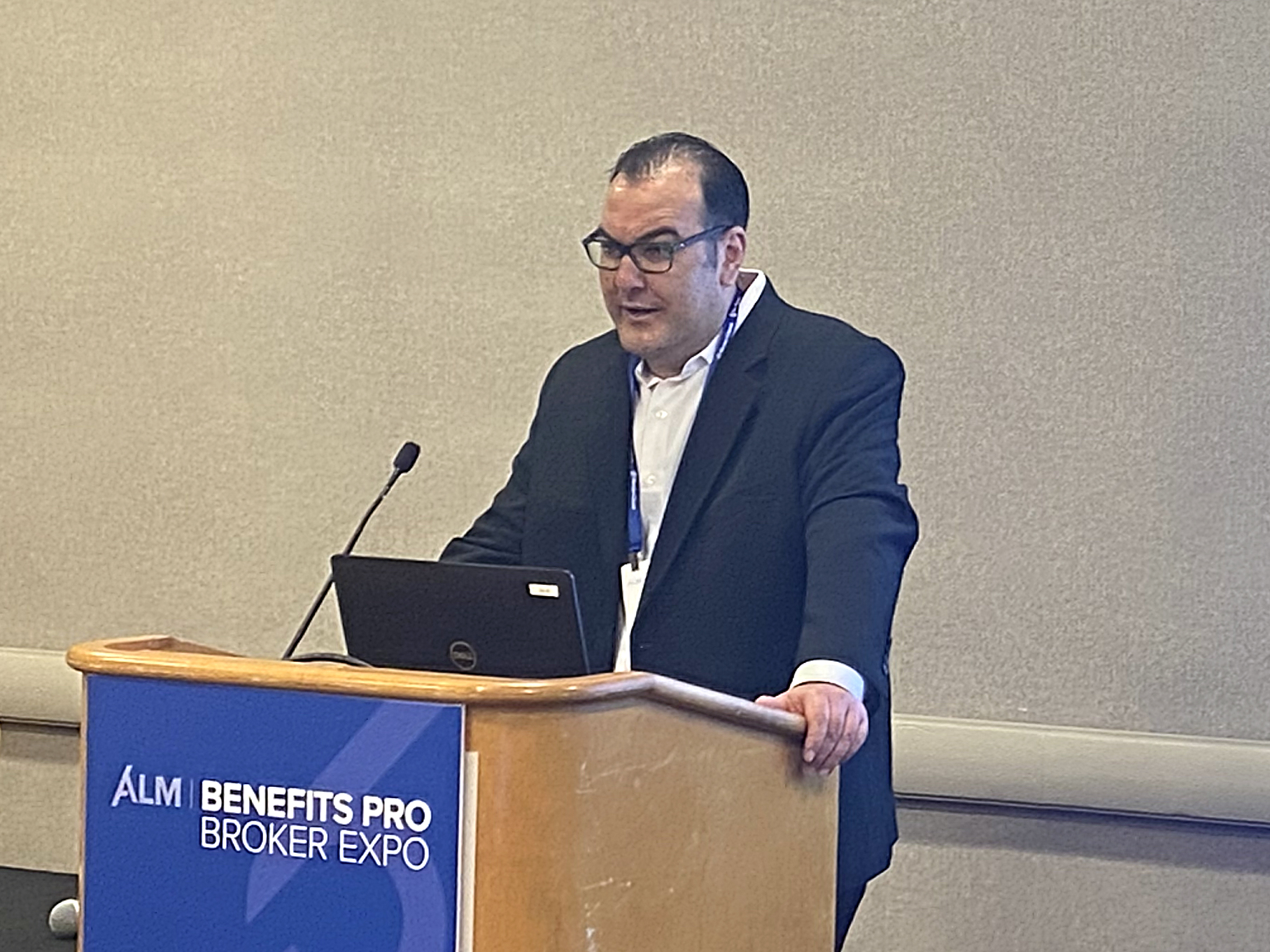 "Financial wellness is clearly a hot topic," said Chad Schneider, Head of Broker Partnerships at Origin, who presented the "How to Leverage Financial Wellness to Maximize Your Bottom Line" session at Broker Expo in Atlanta. "It went from a nice to have to a need to have for employers."
"Financial wellness is clearly a hot topic," said Chad Schneider, Head of Broker Partnerships at Origin, who presented the "How to Leverage Financial Wellness to Maximize Your Bottom Line" session at Broker Expo in Atlanta. "It went from a nice to have to a need to have for employers."
"It's now a global economy and everything is so volatile that people are getting stressed now," he said, and "it now becomes 'How do I put something in place?' instead of a check-the-box solution."
"Financial illiteracy of our country" is widespread, said Schneider. "There are so many people that are stressed out, not prepared for anything major to happen. They make decisions in a vacuum, don't know what to do for financial advice." So there is a strong need for employers to bridge the gap for employees by providing financial help, said Schneider.
Recommended For You
"Many people are living on the edge of financial distress," he said, because of the following reasons:
- 53% of adults are financially anxious
- 2 in 3 families lack an emergency fund
- 40% of Americans could not cover a $400 emergency
- 3 in 5 adults do not keep a budget
- 54% of millennials are concerned about student loans
What is holistic financial wellness?
Financial wellness is not new, but it is time to "shine a light on it," said Schneider. "That's the opportunity for all you brokers out there," he said, "You have the ability to have this conversation. There are so many employers that want to have this conversation … Today, employers are looking for a holistic financial wellness program that covers mental, physical, and financial that can help every employee."
A holistic financial wellness approach, he said, should encompass these aspects:
- Managing money to meet everyday expenses
- Spending within one's means for long-term success
- Preparing for contingencies (emergency expenses, sudden loss of income or loss of a loved one)
- Increased peace of mind and understanding of cash flow (for an individual or couple)
- Empowerment and education to make informed financial decisions
- Having a handle on debt and a plan to become debt-free
"This new holistic approach gives employees access to the tools, the resources, the financial professionals to be able to now get that full financial component any aspect of budgeting and things of that nature that's the evolution that we are seeing," said Schneider. That means the program should be:
- Personalized: Every individual has a unique background and experiences with money that led them to their current financial state. A one-size fits all approach will alienate part of the workforce, so it must be a personalized solution.
- Cost-effective: Employer sponsored plans should be inclusive and cost-effective for the entire workforce.
- Convenient: Remove barriers to financial success by providing easy and convenient access to education and information, and by removing barriers to executing on financial tasks.
Related: Inflation pain: 44% of Americans are living paycheck to paycheck
Financial wellness is now the number #1 requested employee benefit, according to Schneider, whose company has surveyed companies they've work with over the last three years about this topic. "The number one thing that employees are asking for is to talk to an advisor, understand finances, resources to navigate the crazy economy that we are currently living in," he said.
Since a financial advisor is out of reach for employees, he said, most employees (93%) "want their company to offer increased access to financial planning (but only 28% do so)," he said.
"We hear the term corporate responsibility more and more," said Schneider. "Financial health starts at work. For most of your employees, you are their only source of wealth. Financial wellness is top of mind for employers," and here is how financial wellness has changed in the workplace over the last few years, according to Schneider:
- A must-have benefit: Nearly all (94%) employers say they're very likely or moderately likely to provide workers with resources to help them improve financial wellbeing in areas beyond retirement decisions.
- Utilization of program: Holistic financial wellness solutions should see an average of 5x engagement relative to traditional financial wellness solutions.
- Financial wellness redefined: 59% of employers are now looking to offer specific tools to their employees to help with topics like budgeting, debt management and financial planning. This is up from 35% in 2018.
- Technology-focused: 58% of employers are looking for tech-focused financial wellness solutions for their employees, including mobile apps and online tools.
Financial wellness will also drive revenue for the employer, says Schneider, in the following ways:
- Increase voluntary benefit sales (life insurance, disability insurance, etc.): Recommendations based on life events to purchase additional products already offered through employer.
- Increase 401(k): Employees have increased 401(k) contributions by $2,000 in their first year.
- Increase HDHP & HSA participation: Financial planners educate employees on tax advantages of HSA that drives increased participation.
- Improve benefit utilization: Financial planners are trained on employee benefits and can help employees better understand the value of their offering.
"A growing number of companies are considering the different financial issues their workers are struggling with and adjusting their benefits packages accordingly," said Schneider. "Especially now, as HR teams brace to support employee well-being during a once-in-a-generation economic shift. Advances in technology and data are changing the financial wellness landscape How investments into financial wellbeing improve employee health and productivity, as well as your business's bottom line."
Here are the types of financial wellness programs that currently exist:
- Financial literacy programs
- Financial wellness platforms
- Budgeting and cash flow management
- Tax guidance & preparation
Once a financial wellness program is in place, here are the positive behavior change employers can look for in their employees over a 12-month period:
- 27% increase in users built up a 3-6 month emergency savings fund.
- 15% increase in users contributing to their retirement plan.
- 10% increase in users contributing enough to get their full employer retirement match.
- 28% increase in users that pay off their credit card in full every month
- 32% increase in users on-track with their financial goals.
"Demographics are transforming the modern benefits package," said Schneider. One key statistic is that that 76% of millennials lack basic financial knowledge, as well as:
- 30% of the workforce will be Gen Zers by 2030 — the most ethnically and racially diverse generation in history
- 69% of Generation Z and millennial employees are women
- 78% of employees say it's important to them that their employer prioritizes diversity and inclusion
"To best serve a diverse range of employees," said Schneider, "a financial wellness solution should recruit professionals that are more diverse than the general financial professional population—across race, gender, language, career background, and more."
© Touchpoint Markets, All Rights Reserved. Request academic re-use from www.copyright.com. All other uses, submit a request to [email protected]. For more inforrmation visit Asset & Logo Licensing.







